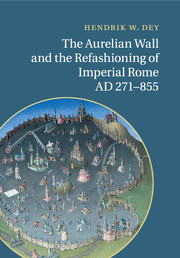Book contents
- Frontmatter
- Contents
- List of abbreviations
- List of figures
- Acknowledgements
- Introduction
- 1 Toward an architectural history of the Aurelian Wall, from its beginnings through the ninth century
- 2 Planning, building, rebuilding, and maintenance: the logistical dynamics of a (nearly) interminable project
- 3 Motives, meaning, and context: the Aurelian Wall and the late Roman state
- 4 The city, the suburbs, and the Wall: the rise of a topographical institution
- 5 Sacred geography, interrupted
- 6 The Wall and the “Republic of St. Peter”
- Conclusion
- Appendices
- Bibliography
- Index
4 - The city, the suburbs, and the Wall: the rise of a topographical institution
Published online by Cambridge University Press: 19 May 2011
- Frontmatter
- Contents
- List of abbreviations
- List of figures
- Acknowledgements
- Introduction
- 1 Toward an architectural history of the Aurelian Wall, from its beginnings through the ninth century
- 2 Planning, building, rebuilding, and maintenance: the logistical dynamics of a (nearly) interminable project
- 3 Motives, meaning, and context: the Aurelian Wall and the late Roman state
- 4 The city, the suburbs, and the Wall: the rise of a topographical institution
- 5 Sacred geography, interrupted
- 6 The Wall and the “Republic of St. Peter”
- Conclusion
- Appendices
- Bibliography
- Index
Summary
The second part of this study is animated by the central question, hitherto almost untouched, of what the Aurelian Wall “did” to Rome. In part, I want to consider the effects of the Wall on the fabric of the city, on the way it looked and the way it functioned, and thus on the activities of people living within and around it, whose lives it touched in a variety of ways. But I am equally concerned with the Wall's impact on the concept of Rome in late antiquity and the early Middle Ages, and its place in the cognitive landscapes of Romans and outsiders, which in turn conditioned the representations of “Rome” exported abroad and vaunted at home. In what follows, we will consider some of the more salient results of the immuring of Rome, first in terms of topography and infrastructure, and then in the following chapter in relation to prevailing conceptions of urban space and the limits thereof, before turning in the final chapter to the place the Wall had come to occupy after a half-millennium spent seeping into the spirit and fabric of the city, when as the pre-eminent embodiment of “Rome” – as reality and as ideal – it became instrumental in the creation of a new papal capital that was simultaneously the regional hub of a nascent ecclesiastical state, and the quasi-mythical focal point of an immeasurably vaster spiritual empire.
- Type
- Chapter
- Information
- Publisher: Cambridge University PressPrint publication year: 2011

